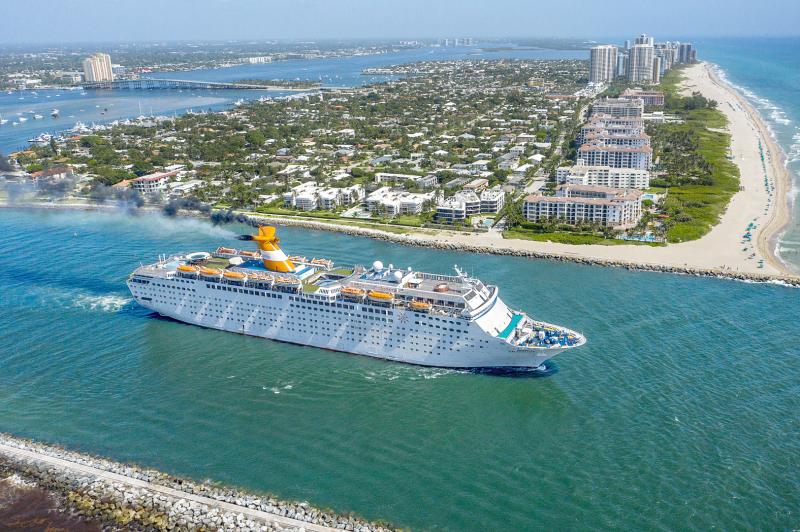Hopes that the world’s cruise industry would be gathering steam again in time for the holiday season that begins this month are sinking, as some ports remain closed and authorities impose new COVID-19 health rules.
With the spread of the novel coronavirus in Europe slowing in the past few months many had expected that the height of the Mediterranean cruise season could be salvaged.
The reopening of six key Greek tourist ports on Saturday last week for cruise ship lines fueled such hopes.

Photo: AP
However, Monday’s decision by industry leader Carnival Cruise Line to postpone its first cruises in months due to the lack of a green light from Italy shows that many difficulties remain.
On the same day, Norwegian operator Hurtigruten AS suspended its expedition trips after dozens of cases were detected among the crew and passengers after two cruises on one vessel last month.
Norway then slapped restrictions on popular cruises to its fjords, with a second ship ordered into quarantine.
However, Europe’s main cruise operators, Costa Cruises and MSC Cruises Ltd, are not giving up.
“We are ready, we have worked very hard,” MSC chief executive officer Gianni Onorato said on Tuesday as the firm presented new health and safety measures.
“We are waiting for the green light from Italian authorities” and “hope to be able to announce some very good news within a few days,” he added.
For its part, Costa Cruises, which is part of the Carnival group, told reporters that it is “working on plans for a gradual resumption of cruises when the authorities of the home and destination ports say it is possible to do so.”
“There are several signals that seem to be favorable for the second half or even the second week of August,” said Erminio Eschena, head of Clia France, an association that groups together the main cruise lines.
Cruise lines have been working hard to develop new health protocols.
They have tried to anticipate each detail with repeated health checks for passengers and crew, as well as beefed-up medical teams.
Costa Cruises’ new guidelines say all passengers are subject to a health check as they board and that “all crew members are subject to daily body temperature checks and their state of health is monitored constantly,” according to its Web site.
Meanwhile, MSC plans daily temperature checks of passengers and crew, and said that physical distancing would be possible thanks to a reduction to 70 percent of passenger capacity.
Both plan to reduce the size of groups for activities.
“The measures taken go beyond the recommendations of bodies, such as the WHO or the EU,” Eschena said.
However, Hurtigruten had testing and quarantine rules in place, which apparently led the ship’s doctor to discount the possibility that a crew member had contracted COVID-19.
“They told me everyone had been tested and all the crew had respected the quarantine rules,” the doctor, Karl-Borre Andersen, told Norwegian daily Verdens Gang.
With the novel coronavirus known to spread in confined spaces, national authorities have been skittish.
Many remember the ordeal of the Diamond Princess and its 4,000 passengers as it spent the month of February in quarantine off Japan and the number of infections climbing to 700.
Another fresh memory is the case of the SeaDream 1, a second cruise ship ordered into quarantine by Norway after a Danish passenger who had disembarked several days previously tested positive for the novel coronavirus.
“We are all shut indefinitely in our own cabins. Room service is going to be busy and there is still 10 days to go” in the quarantine, Rune Vidar Nordum wrote on Twitter.
Champagne and canapes were helping ward away despair for the moment.
“We are well and the captain and crew are taking good care of us,” he tweeted, adding a picture of two flutes of bubbly and a plate of mini-sandwiches.
Experts wonder whether the industry would be able to adapt to the pandemic before there is a cure.
“The industry presents a clear risk as have shown certain inextricable situations, and it affects primarily senior citizens who are more fragile,” said Didier Arino, head of the Protourisme consulting firm in Paris.
“For an industry which has enjoyed nearly uninterrupted growth for 20 years it is difficult to imagine a real recovery until there is a vaccine,” he said.

TECH CLUSTER: The US company’s new office is in the Shalun Smart Green Energy Science City, a new AI industry base and cybersecurity hub in southern Taiwan US chip designer Advanced Micro Devices Inc (AMD) yesterday launched an office in Tainan’s Gueiren District (歸仁), marking a significant milestone in the development of southern Taiwan’s artificial intelligence (AI) industry, the Tainan City Government said in a statement. AMD Taiwan general manager Vincent Chern (陳民皓) presided over the opening ceremony for the company’s new office at the Shalun Smart Green Energy Science City (沙崙智慧綠能科學城), a new AI industry base and cybersecurity hub in southern Taiwan. Facilities in the new office include an information processing center, and a research and development (R&D) center, the Tainan Economic Development Bureau said. The Ministry

ADVERSARIES: The new list includes 11 entities in China and one in Taiwan, which is a local branch of Chinese cloud computing firm Inspur Group The US added dozens of entities to a trade blacklist on Tuesday, the US Department of Commerce said, in part to disrupt Beijing’s artificial intelligence (AI) and advanced computing capabilities. The action affects 80 entities from countries including China, the United Arab Emirates and Iran, with the commerce department citing their “activities contrary to US national security and foreign policy.” Those added to the “entity list” are restricted from obtaining US items and technologies without government authorization. “We will not allow adversaries to exploit American technology to bolster their own militaries and threaten American lives,” US Secretary of Commerce Howard Lutnick said. The entities

Minister of Finance Chuang Tsui-yun (莊翠雲) yesterday told lawmakers that she “would not speculate,” but a “response plan” has been prepared in case Taiwan is targeted by US President Donald Trump’s reciprocal tariffs, which are to be announced on Wednesday next week. The Trump administration, including US Secretary of the Treasury Scott Bessent, has said that much of the proposed reciprocal tariffs would focus on the 15 countries that have the highest trade surpluses with the US. Bessent has referred to those countries as the “dirty 15,” but has not named them. Last year, Taiwan’s US$73.9 billion trade surplus with the US

The Taipei International Cycle Show (Taipei Cycle) yesterday opened at the Taipei Nangang Exhibition Center, with the event’s organizer expecting a steady recovery in the industry this year following a tough last year. This year, 980 companies from 35 countries are participating in the annual bicycle trade show, showcasing technological breakthroughs and market development trends of the bicycle industry at 3,600 booths, the Taiwan External Trade Development Council (TAITRA, 外貿協會) said in a statement. Under the theme “Ride the Revolution,” the exhibition has attracted more than 3,500 international buyers from 80 countries to preregister for the four-day event, which is expected to